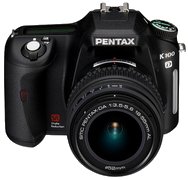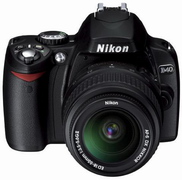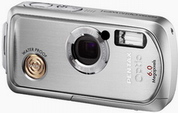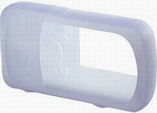Picked up a SanDisk 4GB microSDHC package to upgrade the storage capacity of my Pentax K100D. The package because contains a 4GB microSD, an SD adapter, and a USB SD reader so I figured it’s a good deal. As soon as I got home I excitedly plugged the microSD into the adapter and the adapter into the camera. Memory card error. WTH? I removed the adapter, plugged it into the reader, and plugged that into the PC. Works fine. I did a search and discovered that, as I suspected, the camera does not support SDHC! Fortunately, there is a version 1.02 firmware update that provides support for SDHC. I promptly downloaded and started the update. After a few tense minutes (there is always that risk of turning your beloved electronic gadget into a brick) the update completed. I restarted the camera and lo and behold: 1386 photos at highest resolution and best quality!
Digital vs Film Camera
My college dorm mate posted in our mailing list this link to a blog entry written by her friend: Why I Don’t Like Using A Digital Camera In My Personal Life. It’s a personal preference thing but I do have comments on some points:
With a digital camera, it takes at least 30 seconds to get back into the holiday because of the irresistable need to review the image, check the histogram, zoom in to see if it is really focussed well or not (and too often it isn’t) and then more often than not, I’ll take another picture of the same thing because I might not be totally satisfied with the one I just reviewed – or I’m just not sure if I am – it’s hard to really judge an image on a tiny LCD in the bright outdoors. During that 30 seconds or so, I am no longer ‘in the moment’ of the holiday or the outing. My attention has been taken completely off the environment while I was reviewing the image on the digital camera. I resent that.
There’s a term for this: chimping. You go take a picture, then review, then take picture, then review, ad nausaum. You don’t have to do this. You have to not do this. Take that shot and go on. It just takes some discipline and confidence in your photography skills. That being said, I chimp more often than I want :D
And I really resent that the LCD monitor on the digital camera is so darn hard to view in the bright outdoors.
It’s true that LCD monitors, especially older ones, are sometimes hard to view so it’s still good to get a digital camera with a dedicated viewfinder aside from an LCD monitor. Then you can also have the option of turning off the LCD monitor, just use the viewfinder, and reduce the temptation to go chimping. Sadly, this is not an option if you want an ultra-compact camera as most dispense with the viewfinder in the interest of compactness.
I especially resent the time I have to spend in the hotel room every night transferring the images from the memory card to the laptop computer, reviewing the images yet again during the transfer process, and setting up the battery charger for the evening.
This is probably because the article was written in 2004 and a lot has changed since. If you take that many photos that you need to do this, there’s a solution. Get bigger storage capacity. That way you don’t need to transfer to your laptop nor do you even need to bring a laptop. Note that it’s better to have 4 1Gb cards than 1 4Gb card for safety purposes. Besides, if you take that many photos, you’d be worrying about rolls and rolls of film.
As for the battery, these can actually last hundreds of shots, unless you use the flash a lot in which case you’d still need to worry about batteries whether it’s a digital camera or a film camera. In this case, there are digital cameras that use rechargeable AA batteries. The same batteries for both the camera and your dedicated flash unit, if you have it. And if you abhor recharging, you can just grab some disposable AA batteries off the shelf of almost any store. But that’s not too environment friendly.
And The Winner Is… The Pentax K100D!
 After much deliberation, I finally made my decision and got the Pentax K100D. There are two major reasons why I chose it over the Nikon D40.
After much deliberation, I finally made my decision and got the Pentax K100D. There are two major reasons why I chose it over the Nikon D40.
The first reason is the feature set: it has just too many higher-end DSLR features to pass up. In fact, you could mistake it for a higher-end camera if not for the 6 megapixel resolution.
This approach of putting higher-end features to a lower-end camera also applies to its bigger brother, the Pentax K10D, which I almost considered. Unfortunately, though it is a bargain by itself, it was just too pricey for my intended use.
The second reason is I was turned off by the local Nikon distributor’s representative who was all impatient and arrogant when I made inquiries. They may have their reasons and they may be makings tons of money selling Nikons but they sure won’t be making it from yours truly.
I’ve been playing around with my K100D for the past few days and I must say I’m quite happy so far. It’s very intuitive: I figured out most of the functions without reading the manual. And, of course, it takes great pictures. They could be a lot better in terms of composition, lighting, etc but in terms of image capture it’s pretty much spot on. More here as I get to know the camera better.
Pentax K100D vs Nikon D40
 |
 |
I’ve been planning to dabble in a bit more serious photography for some time now. Nothing so serious as to go for monster DSLRs with gazillions of pixels. Just enough to get to know the technical aspects. So the answer is one of those entry-level DSLRs that have been popping around all over lately. The choice has boiled down to the Pentax K100D and the Nikon D40. Both good entry-level DSLRs.
I’ve been comparing them for some time now and the way I see it, the K100D has higher-end DSLR features that the D40 does not: Shake Reduction (SR), dust removal, 11-point AF (D40 has 3-point AF), built-in AF motor, depth-of-field (DOF) preview, auto exposure bracketing, and top LCD status display. As a bonus, it uses widely available AA batteries. With 2500mAh and even 2700mAh rechargeable batteries becoming available, longevity should not be an issue.
On the other hand, the D40 has two things the K100D does not have: dedicated AF-assist lamp and large continuous shooting buffer. The D40 also is generally better in terms auto white balance (AWB), metering, noise reduction, and image processor.
However, in terms of picture quality, it’s a toss-up. From the sample shots I’ve seen, usually the K100D’s has better colors and the D40’s are sharper. But there are quite a lot of exceptions to this.
Tough choice.
Pentax Optio WPi
 |
 |
The Pentax Optio WPi is a camera you can bring almost anywhere, almost anytime. It is small, compact, and waterproof! (up to 5 ft for 30 minutes). Wrap it in the optional silicone rubber skin and it’s also reasonably rugged, too. It’s got good camera specs too: 6 megapixels, 3x optical zoom, and 2″ LCD monitor. The picture quality is pretty good. At the default setting, pictures are on the soft side but this can be adjusted easily. Quite good enough for snap shooting use.
This is the second of the “h2o cameras”. The first being the WP. The W10 was already available when I got this camera then but decided to get the WPi because of its slightly more compact size and lower price. As of this writing, the WP and the WPi have been discontinued and the W20 is out.
One gripe I have with the WPi is that it doesn’t have an autofocus assist lamp and thus does poorly at focusing under low-light conditions. Good thing there’s a manual focus feature. Another is that water drops sometimes sticks onto the lens, causing smudged pictures. But that’s what you get for using a camera in wet conditions. You just have to wipe the lens before taking shots.
Rating: 4/5